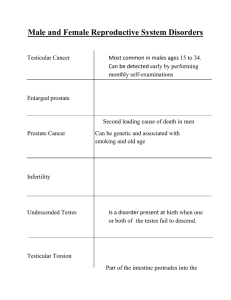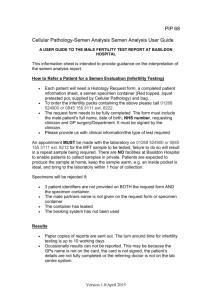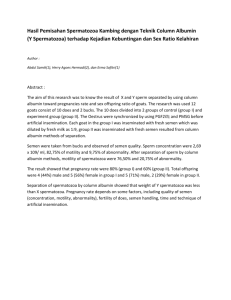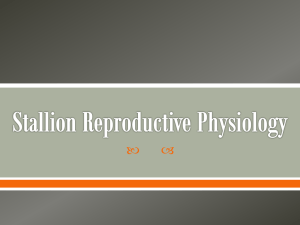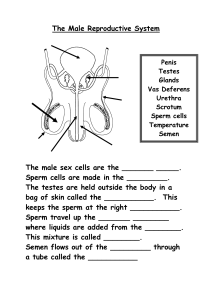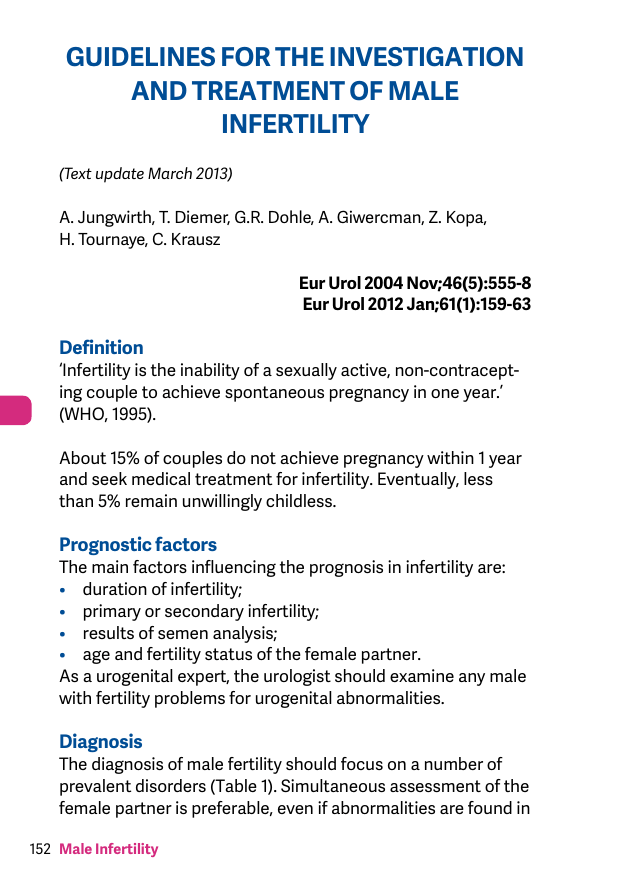
GUIDELINES FOR THE INVESTIGATION AND TREATMENT OF MALE INFERTILITY (Text update March 2013) A. Jungwirth, T. Diemer, G.R. Dohle, A. Giwercman, Z. Kopa, H. Tournaye, C. Krausz Eur Urol 2004 Nov;46(5):555-8 Eur Urol 2012 Jan;61(1):159-63 Definition ‘Infertility is the inability of a sexually active, non-contracepting couple to achieve spontaneous pregnancy in one year.’ (WHO, 1995). About 15% of couples do not achieve pregnancy within 1 year and seek medical treatment for infertility. Eventually, less than 5% remain unwillingly childless. Prognostic factors The main factors influencing the prognosis in infertility are: • duration of infertility; • primary or secondary infertility; • results of semen analysis; • age and fertility status of the female partner. As a urogenital expert, the urologist should examine any male with fertility problems for urogenital abnormalities. Diagnosis The diagnosis of male fertility should focus on a number of prevalent disorders (Table 1). Simultaneous assessment of the female partner is preferable, even if abnormalities are found in 152 Male Infertility the male, since data show that in 1 out of 4 couples both male and female partners have pathological findings. Table 1: Reasons for a reduction in male fertility Congenital factors (cryptorchidism and testicular dysgenesis, congenital absence of the vas deferens) Acquired urogenital abnormalities (obstructions, testicular torsion, testicular tumour, orchitis) Urogenital tract infections Increased scrotal temperature (e.g. due to varicocele) Endocrine disturbances Genetic abnormalities Immunological factors (autoimmune diseases, antisperm antibodies) Systemic diseases (diabetes, renal and liver insufficiency, cancer, hemochromatosis) Exogenous factors (medications, toxins, irradiation) Lifestyle factors (obesity, smoking, drugs, anabolic steroids) Idiopathic (40-50% of cases) Semen analysis Semen analysis forms the basis of decisions concerning further treatment. Analysis should be performed in a laboratory adhering to national quality control standards (Table 2). Table 2: Lower reference limits (5th centiles and 95% confidence intervals) for semen characteristics* Parameter Lower reference limit (95% CI) Semen volume (mL) 1.5 (1.4-1.7) Total sperm number (106 per ejaculate) 39 (33-46) Sperm concentration (106 per mL) 15 (12-16) Male Infertility 153 Total motility (PR+NP, %) Progressive motility (PR, %) Vitality (live spermatozoa, %) Sperm morphology (normal forms, %) Other consensus threshold values pH Peroxidase-positive leukocytes (106 per mL) MAR test (motile spermatozoa with bound particles, %) Immunobead test (motile spermatozoa with bound beads, %) Seminal zinc (μmol/ejaculate) Seminal fructose (μmol/ejaculate) Seminal neutral glucosidase (mU/ejaculate) 40 (38-42) 32 (31-34) 58 (55-63) 4 (3.0-4.0) ≥ 7.2 < 1.0 < 50 < 50 ≥ 2.4 ≥ 13 ≥ 20 *WHO Manual for Semen Analysis, 5th edn, 2010. Recommended number of semen analyses If values are normal, one test should suffice. If the results are abnormal, semen analysis should be repeated. It is important to distinguish between oligozoospermia (< 15 million spermatozoa/mL), asthenozoospermia (< 40% motile spermatozoa) and teratozoospermia (< 4% normal forms). Quite often, all three pathologies occur at the same time, i.e. as oligo-astheno-teratozoospermia (OAT) syndrome. In extreme cases of OAT syndrome (< 1 million spermatozoa/mL), just as with azoospermia, there is an increased incidence of genetic abnormalities and/or obstruction of the male genital tract. Hormonal investigation Endocrine malfunctions are more prevalent in infertile men than in the general population, but are still quite uncommon. 154 Male Infertility Hormonal screening can be limited to determining the levels of follicle stimulating hormone (FSH), luteinizing hormone (LH), testosterone and sex hormone binding globulin (SHBG) in cases of abnormal semen parameters. In men diagnosed with azoospermia or extreme OAT, it is important to distinguish between obstructive and non-obstructive causes. Criteria with a reasonable predictive value for obstruction are a normal FSH with bilaterally normal testicular volume. However, 29% of infertile men with a normal FSH appear to have defective spermatogenesis. Hypergonadotrophic hypogonadism (elevated FSH/LH) Impaired spermatogenesis associated with elevated levels of gonadotrophins is a common problem and is due to primary testicular failure. Causes include: • Congenital - Klinefelter’s syndrome, anorchia, cryptorchidism, testicular dysgenesis, Y chromosome microdeletions; • Acquired - after orchitis, testicular torsion, testicular tumour, systemic illness, cytotoxic therapy. Hypogonadotrophic hypogonadism (low FSH/LH) Low levels of gonadotrophins due to dysfunction of the pituitary gland or hypothalamus are rare and may occur as a result of: • Congenital anomalies - idiopathic Hypogonadotrophic Hypogonadism (iHH), Kallmann’s syndrome, Prader-Willi syndrome; • Acquired anomalies - acquired hypothalamic/pituitary gland diseases (malignant CNS tumours, pituitary adenoma, hyperprolactinaemia, granulomatous illness, hemochromatosis); • Exogenous factors - drugs (anabolic steroids, obesity, irradiation). Male Infertility 155 If unexplained hypogonadotrophic hypogonadism is present, the medical examination should include magnetic resonance imaging (MRI) of the pituitary gland. Microbiological assessment Indications for microbiological assessment include abnormal urine samples, urinary tract infections, male accessory gland infections (MAGI) and sexually transmitted diseases (STDs). White blood cells detected in a semen sample, in combination with a small ejaculate volume, may point to a (partial) obstruction of the ejaculatory ducts caused by a (chronic) infection of the prostate or seminal vesicles. Genital infections may instigate the production of spermatotoxic free oxygen radicals. Neisseria gonorrhoea and Chlamydia trachomatis infections can also cause obstruction of the genital tract. Although antibiotic procedures for MAGI might provide improvement in sperm quality, therapy does not necessarily increase the probability of conception. Genetic evaluation A substantial number of andrological fertility disorders that used to be described as idiopathic male infertility have a genetic origin. An extensive family history and karyotype and Y-chromosome deletion analysis will detect a number of these disorders, not only providing a diagnosis, but also enabling appropriate genetic counselling. The latter may be very important with the advent of intracytoplasmic sperm injection (ICSI), because genetic defects may be transferred and a balanced translocation of the infertile father may become unbalanced in the offspring. Chromosomal abnormalities are more common in men with OAT and with azoospermia, and karyotyping is recommended in these men both for diagnosis purposes and for genetic counselling. The most common sex chromosome abnormality 156 Male Infertility is Klinefelter’s syndrome (47, XXY), which affects around 14% of men diagnosed with azoospermia. Klinefelter’s syndrome is characterised by hypergonadotrophic hypogonadism which may be associated with eunuchoid features and/or gynaecomastia. Both testicles are very small due to extensive tubular sclerosis. In 60% of all patients, testosterone levels decrease with age requiring androgen replacement. Furthermore, chromosome translocations and deletions can be found, which may be hereditary and cause habitual abortion and congenital malformations in the offspring. In cases of azoospermia or severe OAT, there may be deletions in the azoospermic factor (AZF) region of the Y-chromosome and testing is advised. The prevalence of Y deletions is considerable (around 5%) in this group of patients. The presence of a Y deletion means that the defect will be passed to sons, who will then also be affected by spermatogenic disturbances or failure. When performing ICSI with surgically retrieved sperm or ejaculated spermatozoa, based on a diagnosis of congenital bilateral/unilateral absence of the vas deferens (CAVD), both the male and the female partner should be tested for mutations in the cystic fibrosis transmembrane regulator (CFTR) gene. Apart from causing cystic fibrosis (CF), this gene is also associated with CAVD; over 85% of all males diagnosed with CAVD also test positive for two CFTR-gene mutations when the entire gene is sequenced. In cases of a homozygous CFTR mutation carrier with a mutation carrier partner, depending on the mutations involved, there is a 50% chance of a child with CF or CAVD. Genetic counselling is mandatory in these cases. Ultrasonography Ultrasonography (US) is a useful tool for locating intrascrotal Male Infertility 157 lesions. Colour Doppler US of the scrotum can detect a varicocele in around 30% of subfertile males. Testicular tumours can be found in 0.5%, and testicular microcalcifications (a potentially premalignant condition) are detected in around 2-5% of subfertile males, especially patients diagnosed with a history of cryptorchidism. Transrectal ultrasonography (TRUS) is indicated in men with a low volume of ejaculate (< 1.5 mL) to exclude obstruction of the ejaculatory ducts caused by a midline prostatic cyst or stenosis of the ejaculatory ducts. Testicular biopsy Testicular biopsy is usually performed as part of a therapeutic process in azoospermic patients (testicular sperm retrieval - TESE) who decide to undergo ICSI. Indications for performing a diagnostic testicular biopsy could be azoospermia or extreme OAT, in the presence of a normal testicular volume and normal FSH levels. The biopsy is aimed at differentiating between testicular insufficiency and obstruction of the male genital tract. It is advised that, during the procedure, tissue that contains spermatozoa is cryopreserved for future ICSI attempts. In addition, testicular biopsies are performed to detect carcinoma in situ of the testis in infertile men with testicular microcalcifications and risk factors for testicular cancer (i.e. male infertility, cryptorchidism, history of a testicular tumour, testicular atrophy). Pathological classifications are: • Absence of seminiferous tubules (tubular sclerosis); • Absence of germ cells (Sertoli cell only syndrome); • Maturation arrest - spermatogenesis arrested at different stages (spermatogonia, spermatocytes or spermatides); 158 Male Infertility • H ypospermatogenesis - all cell types up to spermatozoa are present, but there is a distinct decline in the number of reproducing spermatogonia. Treatment Counselling Lifestyle factors can impair semen quality, e.g. heavy smoking, alcohol abuse, use of anabolic steroids, extreme sports (marathon training, excessive strength sports), and an increase in scrotal temperature through thermal underwear, sauna or hot tub use, or occupational exposure to heat sources. A considerable number of drugs can affect spermatogenesis. Medical (hormonal) treatment Antioxidant treatment (folic acid, vitamin E, zinc, selenium) may have a positive influence on semen quality but infertile couples should be advised that current evidence on their benefit to promote pregnancy is inconclusive. No studies have confirmed that hormonal therapies, such as human menopausal gonadotrophin (HMG)/human chorionic gonadotrophin (HCG), androgen, anti-oestrogens (clomiphene and tamoxifen), prolactin inhibitors (bromocriptine) and steroids, have improved pregnancy rates in men with idiopathic OAT. However, some primarily endocrinological pathologies can be treated medically, including: • Low testosterone: clomiphene citrate 50 mg/day or tamoxifen 20 mg/day; • Hypogonadotrophic hypogonadism: start HCG 1500 IU 3 times per week, and add HMG or FSH 75-150 IU 3 times per week, until spermatogenesis occurs; • Hyperprolactinaemia: dopamine agonists. In patients with anti-sperm antibodies, high-dose steroids are not recommended because of serious side-effects and questionable benefit. Male Infertility 159 Surgical treatment Varicocele The treatment of varicocele is a controversial subject, mainly based on whether there is an actual need to treat varicocele in infertile men. There is evidence of improved semen parameters after successful varicocele treatment. Current information supports the hypothesis that in some men, the presence of varicocele is associated with progressive testicular damage from adolescence onwards and consequent reduction in fertility. Although treatment of varicocele in adolescents may be effective, there is a significant risk of over-treatment. In cases of normal semen analysis and in men with a subclinical varicocele, there appears to be no benefit from treatment compared with observation. Varicocele repair, however, seems effective in couples in whom the men has a oligo- or asthenozoospermia, a clinical varicocele, and otherwise unexplained infertility. Microsurgery/vasovasostomy and epididymovasostomy Only urologists with experience in microsurgery should undertake these procedures using an operating microscope. The likelihood of initiating pregnancy is inversely proportional to the obstruction interval and becomes less than 50% after 8 years. Other important prognostic factors are the quality of the semen after the procedure and the partner’s age. In approximately 15% of men who have undergone a successful vasovasostomy, sperm quality deteriorates to the level of azoospermia or extreme oligospermia within 1 year. Sometimes an epididymal obstruction coexists, especially in men with a long interval between vasectomy and vasovasostomy. In these men a vaso-epididymostomy is indicated. Considering that a vaso-epididymostomy has a limited effect on pregnancy rates (20-30%), it is advisable to combine this procedure with microsurgical epididymal sperm aspiration (MESA), and cryopreserve the harvested spermatozoa 160 Male Infertility for ICSI. The indications for vaso-epididymostomy include obstructions at the level of the epididymis in the presence of a normal spermatogenesis (testicular biopsy). Poor sperm quality and sometimes sperm antibodies after successful vasectomy repair may prevent spontaneous pregnancy and assisted reproduction is indicated. MESA/TESE MESA/testicular sperm extraction (TESE) in combination with ICSI is indicated in men with obstructive azoospermia when reconstruction (vasovasostomy, vaso-epididymostomy) cannot be performed or is unsuccessful. An alternative would be percutaneous aspiration of spermatozoa from the caput epididymis (PESA). In 50-60% of men with non-obstructive azoospermia (NOA), spermatozoa can be found in the testis. Some authors recommend taking several testicular samples, while others advocate microsurgical harvesting of spermatozoa. So far, no clinical or laboratory parameter has been shown to be useful in predicting sperm harvesting in men with NOA. In case of AZFa and AZFb microdeletions, no spermatozoa can be retrieved. Transurethral incision of ejaculatory ducts or midline prostatic cyst Distal obstructions of the genital tract are commonly caused by infections of the prostatic urethra and the accessory glands or by a cyst in the midline of the prostate. Treatment of the obstruction by transurethral incision of the cyst or the ejaculatory ducts (TURED) may lead to an increase in semen quality and, occasionally, spontaneous pregnancy. Long-term results, however, are disappointing. Disorders of ejaculation Retrograde ejaculation and anejaculation can occur: • In neurological diseases, e.g. multiple sclerosis, diabetes Male Infertility 161 mellitus (neuropathy) and spinal cord injuries; • Following prostate surgery, bladder neck surgery, sympathectomy and retroperitoneal surgery, e.g. lymph node dissections for testicular tumours; • During antidepressant therapy. Diagnosis is based on the medical history of post-ejaculate urine. Retrograde ejaculation should also be suspected if the ejaculate volume is very low (partial retrograde ejaculation). Treatment of retrograde ejaculation aimes at removing the cause of the disorder or harvesting spermatozoa from the urine after orgasm. Anejaculation can be treated by vibrostimulation or electro-ejaculation techniques. It is possible to induce ejaculation in around 90% of patients with spinal cord injuries. However, the semen quality is often poor with a low number of motile spermatozoa and increased rates of DNA fragmentation. This accounts for the disappointing results of assisted reproduction techniques in these men. TESE, in-vitro fertilisation, and ICSI are often required. Recommendations Testicular biopsy is the best procedure to define the histological diagnosis and possibility of finding sperm. Spermatozoa should be cryopreserved for use in ICSI. Men with NOA can be offered TESE with cryopreservation of the spermatozoa to be used for ICSI. Testing for microdeletions is not necessary in men with OA (with normal FSH) when ICSI is used because spermatogenesis should be normal. Men with severely damaged spermatogenesis (spermatozoa < 5 million/mL) should be advised to undergo Yq microdeletion testing for both diagnostic and prognostic purposes. Yq microdeletion also has important implications for genetic counselling (see below). 162 Male Infertility GR A A A A If complete AZFa or AZFb microdeletions are detected, micro-TESE is not necessary because it is extremely unlikely that any sperm will be found. If a man with Yq microdeletion and his partner wish to proceed with ICSI, they should be advised that microdeletions will be passed to sons, but not to daughters. Standard karyotype analysis should be offered to all men with damaged spermatogenesis (spermatozoa <10 million/mL) who are seeking fertility treatment by IVF. Genetic counselling is mandatory in couples with a genetic abnormality found in clinical or genetic investigation and in patients who carry a (potential) inheritable disease. When a man has structural abnormalities of the vas deferens (unilateral or bilateral absence), he and his partner should be tested for CF gene mutations. Aetiological treatments for ejaculatory disorders should be offered before sperm collection and ART is performed. A A B A A B This short booklet text is based on the more comprehensive EAU guidelines (978-90-79754-71-7), available to all members of the European Association of Urology at their website, http://www.uroweb.org. Male Infertility 163
